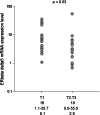Expression of estrogen receptor beta wt isoform (ERbeta1) and ERbetaDelta5 splice variant mRNAs in sporadic breast cancer
- PMID: 17457609
- PMCID: PMC12160905
- DOI: 10.1007/s00432-007-0209-x
Expression of estrogen receptor beta wt isoform (ERbeta1) and ERbetaDelta5 splice variant mRNAs in sporadic breast cancer
Abstract
Purpose: In addition to Estrogen Receptor alpha (ERalpha) and Progesterone Receptor (PR), the Second Estrogen Receptor (ERbeta) appears to play an important role not only in estrogen signaling, but also in the pathogenesis of cancer in estrogen dependent tissues. The existence of various isoforms and splice variants of both ERs additionally complicates elucidation of their physiological role and involvement in the process of carcinogenesis.
Methods: In this study, the expression of ERbeta1 mRNA (wild type of beta receptor) and splice variant ERbetaDelta5 mRNA (which codes for truncated protein) was measured by the quantitative RT-PCR (q RT-PCR) in the 60 samples of Breast Cancer (BC) and correlated with ERalpha and PR protein levels and with clinical and histopathological parameters.
Results: We found the inverse correlation of ERbetaDelta5 mRNA expression with the levels of PR and ERalpha proteins in the group of postmenopausal patients; we also report the lower expression of ERbeta1 and ERbetaDelta5 mRNA in the larger tumors (>20 mm, T2, and T3) than in smaller ones (< or =20 mm, T1). The decrease of ERbetaDelta5 mRNA expression in larger tumors is found to arise from ER-positive breast carcinomas. In addition, the portion of tumors with concomitant high expression of both transcripts matches up the known percentage of tumors resistant to endocrine therapy in patients with different ER/PR status.
Conclusions: As far as we know, this is the first study in which ERbetaDelta5 mRNA splice variant was quantified by real-time RT-PCR in the clinical samples of breast cancer tissue. Until now, the focus of clinical reports was the level of ERbeta1, ERbeta2, and ERbeta5 isoforms. The higher expression of ERbetaDelta5 mRNA is associated with the indicators of low biological aggressiveness of tumor (low tumor size within ER-positive status in our study) suggesting that the uncontrolled local tumor growth may occur as the expression of ERbetaDelta5 mRNA decreases in estrogen-dependent breast cancer.
Figures







References
-
- Ariazi EA, Clark GM, Mertz JE (2002) Estrogen-related receptor alpha and estrogen-related receptor gamma associate with unfavorable and favorable biomarkers, respectively, in human breast cancer. Cancer Res 62:6510–6518 - PubMed
-
- Barkhem T, Carlsson B, Nilsson Y, Enmark E, Gustafsson J, Nilsson S (1998) Differential response of estrogen receptor alpha and estrogen receptor beta to partial estrogen agonists/antagonists. Mol Pharmacol 54:105–112 - PubMed
-
- Bollig A, Miksicek RJ (2000) An estrogen receptor-alpha splicing variant mediates both positive and negative effects on gene transcription. Mol Endocrinol 14:634–649 - PubMed
-
- Brouillet JP, Dujardin MA, Chalbos D, Rey JM, Grenier J, Lamy PJ, Maudelonde T, Pujol P (2001) Analysis of the potential contribution of estrogen receptor (ER) beta in ER cytosolic assay of breast cancer. Int J Cancer 95:205–208 - PubMed
Publication types
MeSH terms
Substances
LinkOut - more resources
Full Text Sources
Other Literature Sources
Medical
Research Materials

